Short-Rotation Coppice Managed According to Ecological Guidelines—What Are the Benefits for Phytodiversity?
Abstract
1. Introduction
2. Materials and Methods
2.1. Study Area and Study Sites
2.2. Survey of the Flora
2.3. Data Preparation and Statistical Analysis
3. Results
3.1. Comparison of Habitat Types
3.1.1. Species Numbers
3.1.2. Species Composition and Species Numbers with Regard to Habitat Preferences
3.1.3. Similarity of Plant Communities
3.2. Comparison of SRC Stand Types
3.2.1. Species Numbers
3.2.2. Species Composition and Species Numbers with Regard to Habitat Preferences
3.2.3. Similarity of Plant Communities
4. Discussion
5. Conclusions
Author Contributions
Funding
Institutional Review Board Statement
Informed Consent Statement
Data Availability Statement
Acknowledgments
Conflicts of Interest
Appendix A
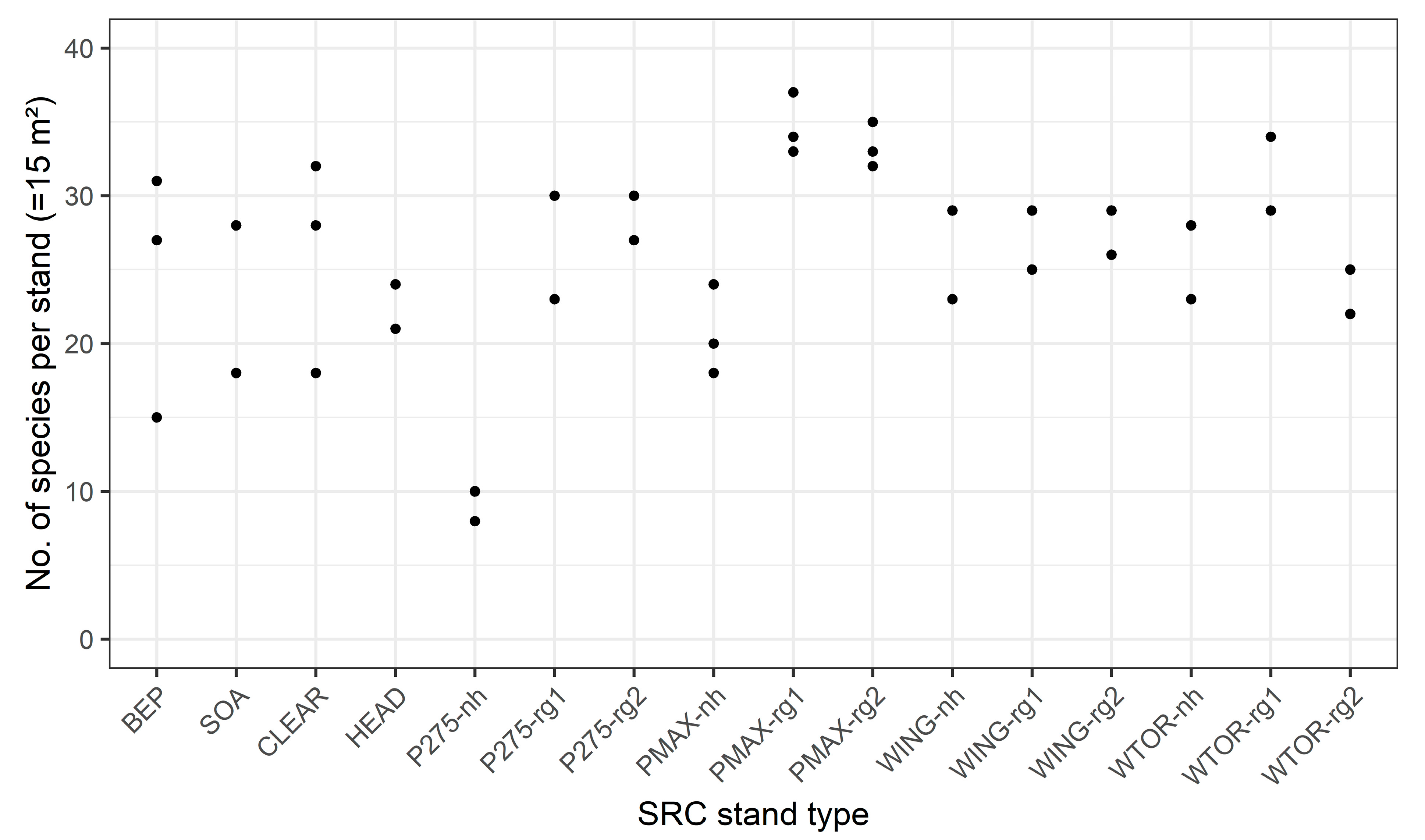
| No. of Species 1 | BEP | SOA | CLEAR | HEAD | P275 | PMAX | WING | WTOR | ||||||||
|---|---|---|---|---|---|---|---|---|---|---|---|---|---|---|---|---|
| -nh | -rg1 | -rg2 | -nh | -rg1 | -rg2 | -nh | -rg1 | -rg2 | -nh | -rg1 | -rg2 | |||||
| overall | 6.1 ± 3.1 ab | 6.3 ± 1.6 abc | 6.8 ± 2.4 abc | 5.7 ± 1.7 abc | 2 ± 1.1 d | 7.6 ± 3.3 abc | 7.7 ± 2.4 abc | 5 ± 2 a | 12.6 ± 3.1 c | 9.8 ± 2.2 abc | 7.8 ± 2.3 abc | 8.6 ± 2.3 abc | 9.1 ± 1.9 abc | 7.2 ± 2.5 abc | 11 ± 3.6 bc | 6.8 ± 2.9 abc |
| a | 0.9 ± 1 a | 1 ± 0.9 ab | 1.2 ± 1.4 ab | 1.6 ± 1 abcd | 1 ± 0.9 abc | 5.4 ± 2 de | 3.4 ± 1.7 abcde | 3.1 ± 1.5 abcde | 8.6 ± 2.4 e | 5.1 ± 2 de | 3.6 ± 1.9 abcde | 4.3 ± 2.2 bcde | 4.5 ± 1.4 cde | 3.1 ± 1.9 abcde | 5.6 ± 2.5 de | 2.7 ± 1.7 abcd |
| r | 3.1 ± 1.7 a | 3.5 ± 1.3 a | 3.8 ± 1.9 a | 1.7 ± 0.9 abc | 0.7 ± 0.7 b | 1.6 ± 1.5 abc | 2.8 ± 1.9 abc | 1 ± 0.8 bc | 2.5 ± 1.3 abc | 3 ± 1.7 a | 2.8 ± 1.2 ac | 2.4 ± 0.7 ac | 3.1 ± 0.8 a | 2.5 ± 1.2 ac | 3.3 ± 0.9 a | 3 ± 0.9 a |
| g | 0.6 ± 0.7 ab | 0.8 ± 0.8 ab | 1 ± 1 ab | 1.9 ± 0.6 a | 0 ± 0 b | 0.1 ± 0.3 b | 0.6 ± 0.6 ab | 0.3 ± 0.5 b | 0.2 ± 0.4 b | 0.6 ± 0.8 ab | 0.5 ± 0.5 ab | 1.2 ± 1.1 ab | 0.8 ± 0.9 ab | 0.6 ± 0.8 ab | 1.1 ± 0.9 ab | 0.8 ± 0.8 ab |
| w | 0.8 ± 0.9 | 0.8 ± 0.6 | 0.2 ± 0.4 | 0.4 ± 0.7 | 0.2 ± 0.5 | 0.4 ± 0.7 | 0.3 ± 0.6 | 0.6 ± 0.8 | 1 ± 0.9 | 0.3 ± 0.5 | 0.8 ± 1 | 0.3 ± 0.6 | 0.2 ± 0.4 | 0.8 ± 1 | 0.8 ± 1.5 | 0.1 ± 0.3 |
References
- Donald, P.F.; Sanderson, F.J.; Burfield, I.J.; van Bommel, F.P.J. Further evidence of continent-wide impacts of agricultural intensification on European farmland birds, 1990–2000. Agric. Ecosyst. Environ. 2006, 116, 189–196. [Google Scholar] [CrossRef]
- Eichenberg, D.; Bowler, D.E.; Bonn, A.; Bruelheide, H.; Grescho, V.; Harter, D.; Jandt, U.; May, R.; Winter, M.; Jansen, F. Widespread decline in Central European plant diversity across six decades. Glob. Chang. Biol. 2020, 1–14. [Google Scholar] [CrossRef]
- Cardoso, P.; Barton, P.S.; Birkhofer, K.; Chichorro, F.; Deacon, C.; Fartmann, T.; Fukushima, C.S.; Gaigher, R.; Habel, J.C.; Hallmann, C.A. Scientists’ warning to humanity on insect extinctions. Biol. Conserv. 2020, 242, 108426. [Google Scholar] [CrossRef]
- Hallmann, C.A.; Ssymank, A.; Sorg, M.; de Kroon, H.; Jongejans, E. Insect biomass decline scaled to species diversity: General patterns derived from a hoverfly community. Proc. Natl. Acad. Sci. USA 2021, 118, e2002554117. [Google Scholar] [CrossRef] [PubMed]
- Kamp, J.; Frank, C.; Trautmann, S.; Busch, M.; Dröschmeister, R.; Flade, M.; Gerlach, B.; Karthäuser, J.; Kunz, F.; Mitschke, A. Population trends of common breeding birds in Germany 1990–2018. J. Ornithol. 2021, 162, 1–15. [Google Scholar] [CrossRef]
- Warren, M.S.; Maes, D.; van Swaay, C.; Goffart, P.; van Dyck, H.; Bourn, N.A.D.; Wynhoff, I.; Hoare, D.; Ellis, S. The decline of butterflies in Europe: Problems, significance, and possible solutions. Proc. Natl. Acad. Sci. USA 2021, 118, e2002551117. [Google Scholar] [CrossRef]
- Stoate, C.; Boatman, N.D.; Borralho, R.J.; Carvalho, C.R.; de Snoo, G.R.; Eden, P. Ecological impacts of arable intensification in Europe. J. Environ. Manag. 2001, 63, 337–365. [Google Scholar] [CrossRef]
- Huston, M.A.; Marland, G. Carbon management and biodiversity. J. Environ. Manag. 2003, 67, 77–86. [Google Scholar] [CrossRef]
- Robertson, G.P.; Dale, V.H.; Doering, O.C.; Hamburg, S.P.; Melillo, J.M.; Wander, M.M.; Parton, W.J.; Adler, P.R.; Barney, J.N.; Cruse, R.M.; et al. Sustainable Biofuels Redux. Science 2008, 322, 49–50. [Google Scholar] [CrossRef]
- Eggers, J.; Tröltzscht, K.; Falcucci, A.; Maiorano, L.; Verburg, P.H.; Framstad, E.; Louette, G.; Maes, D.; Nagy, S.; Ozinga, W.I.M. Is biofuel policy harming biodiversity in Europe? Glob. Chang. Biol. Bioenergy 2009, 1, 18–34. [Google Scholar] [CrossRef]
- Fletcher, R.J.; Robertson, B.A.; Evans, J.; Doran, P.J.; Alavalapati, J.R.R.; Schemske, D.W. Biodiversity conservation in the era of biofuels: Risks and opportunities. Front. Ecol. Environ. 2011, 9, 161–168. [Google Scholar] [CrossRef]
- Everaars, J.; Frank, K.; Huth, A. Species ecology and the impacts of bioenergy crops: An assessment approach with four example farmland bird species. Glob. Chang. Biol. Bioenergy 2014, 6, 252–264. [Google Scholar] [CrossRef][Green Version]
- Immerzeel, D.J.; Verweij, P.A.; van der Hilst, F.; Faaij, A.P.C. Biodiversity impacts of bioenergy crop production: A state-of-the-art review. Glob. Chang. Biol. Bioenergy 2014, 6, 183–209. [Google Scholar] [CrossRef]
- Sauerbrei, R.; Ekschmitt, K.; Wolters, V.; Gottschalk, T.K. Increased energy maize production reduces farmland bird diversity. Glob. Chang. Biol. Bioenergy 2014, 6, 265–274. [Google Scholar] [CrossRef]
- Sage, R.B. Short rotation coppice for energy: Towards ecological guidelines. Biomass Bioenergy 1998, 15, 39–47. [Google Scholar] [CrossRef]
- Dauber, J.; Jones, M.B.; Stout, J.C. The impact of biomass crop cultivation on temperate biodiversity. Glob. Chang. Biol. Bioenergy 2010, 2, 289–309. [Google Scholar] [CrossRef]
- Englund, O.; Dimitriou, I.; Dale, V.H.; Kline, K.L.; Mola-Yudego, B.; Murphy, F.; English, B.; McGrath, J.; Busch, G.; Negri, M.C.; et al. Multifunctional perennial production systems for bioenergy: Performance and progress. WIREs Energy Environ. 2020. [Google Scholar] [CrossRef]
- Pedroli, B.; Elbersen, B.; Frederiksen, P.; Grandin, U.; Heikkilä, R.; Krogh, P.H.; Izakovičová, Z.; Johansen, A.; Meiresonne, L.; Spijker, J. Is energy cropping in Europe compatible with biodiversity?—Opportunities and threats to biodiversity from land-based production of biomass for bioenergy purposes. Biomass Bioenergy 2013, 55, 73–86. [Google Scholar] [CrossRef]
- Dimitriou, I.; Rutz, D. (Eds.) Sustainable Short Rotation Coppice: A Handbook; WIP Renewable Energies: München, Germany, 2015. [Google Scholar]
- Vanbeveren, S.P.P.; Ceulemans, R. Biodiversity in short-rotation coppice. Renew. Sustain. Energy Rev. 2019, 111, 34–43. [Google Scholar] [CrossRef]
- Rowe, R.L.; Street, N.R.; Taylor, G. Identifying potential environmental impacts of large-scale deployment of dedicated bioenergy crops in the UK. Renew. Sustain. Energy Rev. 2009, 13, 271–290. [Google Scholar] [CrossRef]
- Cunningham, M.D.; Bishop, J.D.; McKay, H.V.; Sage, R.B. ARBRE Monitoring—Ecology of Short Rotation Coppice: Four Year Study Involving Wildlife Monitoring of Commercial SRC Plantations Planted on Arable Land and Arable Control Plots; Department of Trade and Industry: London, UK, 2004. [Google Scholar]
- Glaser, T.; Schmidt, P.A. Auswirkungen von Kurzumtriebsplantagen auf die Phytodiversität. In AGROWOOD: Kurzumtriebsplantagen in Deutschland und Europäische Perspektiven; Bemmann, A., Knust, C., Eds.; Weißensee-Verlag: Berlin, Germany, 2010; pp. 153–161. [Google Scholar]
- Britt, C.P.; Fowbert, J.; McMillan, S.D. The ground flora and invertebrate fauna of hybrid poplar plantations: Results of ecological monitoring in the PAMUCEAF project. Asp. Appl. Biol. 2007, 82, 83–90. [Google Scholar]
- Weih, M.; Karacic, A.; Munkert, H.; Verwijst, T.; Diekmann, M. Influence of young poplar stands on floristic diversity in agricultural landscapes (Sweden). Basic Appl. Ecol. 2003, 4, 149–156. [Google Scholar] [CrossRef]
- Baum, S.; Bolte, A.; Weih, M. High value of short rotation coppice plantations for phytodiversity in rural landscapes. GCB Bioenergy 2012, 4, 728–738. [Google Scholar] [CrossRef]
- Gustafsson, L. Plant conservation aspects of energy forestry-a new type of land use in Sweden. For. Ecol. Manag. 1987, 21, 141–161. [Google Scholar] [CrossRef]
- Gustafsson, L. Vegetation dynamics during the establishment phase of an energy forest on a riverside in south-western Sweden. Studia For. Suec. 1988, 178, 1–16. [Google Scholar]
- Baum, S.; Weih, M.; Bolte, A. Stand age characteristics and soil properties affect species composition of vascular plants in short rotation coppice plantations. BioRisk 2012, 7, 51–71. [Google Scholar] [CrossRef]
- Sage, R.B. Factors affecting wild plant communities occupying short rotation coppice crops on farmland in the UK and Eire. In Brighton Crop Protection Conference: Weeds. Proceedings of an International Conference, Brighton, UK, 20–23 November 1995; British Crop Protection Council: Farnham, UK, 1995; pp. 985–990. [Google Scholar]
- Heilmann, B.; Makeschin, F.; Rehfuess, K.E. Vegetationskundliche Untersuchungen auf einer Schnellwuchsplantage mit Pappeln und Weiden nach Ackernutzung. Forstwiss. Cent. 1995, 114, 16–29. [Google Scholar] [CrossRef]
- Birmele, J.; Kopp, G.; Brodbeck, F.; Konold, W.; Sauter, U.H. Successional changes of phytodiversity on a short rotation coppice plantation in Oberschwaben, Germany. Front. Plant Sci. 2015, 6, 1–8. [Google Scholar] [CrossRef] [PubMed]
- Baum, S.; Bolte, A.; Weih, M. Short rotation coppice (SRC) plantations provide additional habitats for vascular plant species in agricultural mosaic landscapes. BioEnergy Res. 2012, 5, 573–583. [Google Scholar] [CrossRef][Green Version]
- Baum, S.; Weih, M.; Busch, G.; Kroiher, F.; Bolte, A. The impact of short rotation coppice plantations on phytodiversity. Appl. Agric. Forestry Res. 2009, 59, 163–170. [Google Scholar]
- Hennemann-Kreikenbohm, I.; Jennemann, L.; Peters, W.; Wilhelm, E.-G. Nature Conservation Requirements of Short Rotation Coppice Management. In Bioenergy from Dendromass for the Sustainable Development of Rural Areas; Butler Manning, D., Bemmann, A., Bredemeier, M., Lamersdorf, N., Ammer, C., Eds.; Wiley: Weinheim, Germany, 2015; pp. 97–104. ISBN 3527337644. [Google Scholar]
- Soo, T.; Tullus, A.; Tullus, H.; Roosaluste, E. Floristic diversity responses in young hybrid aspen plantations to land-use history and site preparation treatments. For. Ecol. Manag. 2009, 257, 858–867. [Google Scholar] [CrossRef]
- Landkreis Emsland. Die Gemeinden im Landkreis Emsland: Strukturdaten im Vergleich 2016, Meppen. 2016. Available online: https://www.emsland.de/das-emsland/zahlen-und-daten/strukturdaten/strukturdaten.html (accessed on 4 February 2021).
- DWD. Deutscher Wetterdienst (Ed.): Temperatur und Niederschlag, vieljährige Mittelwerte 1981–2010. Available online: https://www.dwd.de/DE/leistungen/klimadatendeutschland/vielj_mittelwerte.html (accessed on 4 February 2021).
- LBEG. Bodenkundliche Übersichtskarte von Niedersachsen und Bremen 1:500 000; Landesamt für Bergbau, Energie und Geologie: Hannover, Germany, 1999. [Google Scholar]
- Rothmaler—Exkursionsflora von Deutschland. Gefäßpflanzen: Grundband; Jäger, E.J., Ed.; 21 Durchgesehene Auflage; Springer: Berlin/Heidelberg, Germany, 2017; ISBN 978-3-662-49707-4. [Google Scholar]
- Moral, R.d.A.; Hinde, J.; Demetrio, C. R Package ’hnp’; R Foundation for Statistical Computing: Vienna, Austria, 2018. [Google Scholar]
- R Core Team. R Version 4.0.4; R Core Team: Vienna, Austria, 2021. [Google Scholar]
- Bates, D.; Maechler, M.; Bolker, B.; Walker, S.; Christensen, R.H.B.; Singmann, H.; Dai, B.; Scheipl, F.; Grothendieck, G.; Green, P.; et al. R Package ’lme4’; R Core Team: Vienna, Austria, 2019. [Google Scholar]
- Kuznetsova, A.; Brockhoff, P.B.; Christensen, R.H.B.; Jensen, S.P. R Package ’lmerTest’; R Foundation for Statistical Computing: Vienna, Austria, 2020. [Google Scholar]
- Lenth, R.; Singmann, H.; Love, J.; Buerkner, P.; Herve, M. R Package ’emmeans’; R Foundation for Statistical Computing: Vienna, Austria, 2019. [Google Scholar]
- Wickham, H.; Chang, W.; Henry, L.; Pedersen, T.L.; Takahashi, K.; Wilke, C.; Woo, K.; Yutani, H. R Package ’ggplot2’; R Foundation for Statistical Computing: Vienna, Austria, 2019. [Google Scholar]
- Gotelli, N.J.; Colwell, R.K. Quantifying biodiversity: Procedures and pitfalls in the measurement and comparison of species richness. Ecol Lett 2001, 4, 379–391. [Google Scholar] [CrossRef]
- McAleece, N.; Gage, J.D.G.; Lambshead, P.J.D.; Paterson, G.L.J. BioDiversity Professional Statistics Analysis Software; Scottish Association for Marine Science: Oban, UK, 1997. [Google Scholar]
- Oberdorfer, E. Pflanzensoziologische Exkursionsflora, 8th ed.; Verlag Eugen Ulmer: Stuttgart, Germany, 2001. [Google Scholar]
- Oksanen, J.; Blanchet, F.G.; Kindt, R.; Legendre, P.; McGlinn, D.; Minchin, P.R.; O’hara, R.B.; Simpson, G.L.; Solymos, P.; Stevens, M.H.H.; et al. R Package ‘vegan’; R Foundation for Statistical Computing: Vienna, Austria, 2020. [Google Scholar]
- Warnes, G.R.; Bolker, B.; Bonebakker, L.; Gentleman, R.; Huber, W.; Liaw, A.; Lumley, T.; Maechler, M.; Magnussen, A.; Moeller, S.; et al. R Package ‘gplots’; R Foundation for Statistical Computing: Vienna, Austria, 2020. [Google Scholar]
- Metzing, D.; Garve, E.; Matzke-Hajek, G.; Adler, J.; Bleeker, W.; Breunig, T.; Caspari, S.; Dunkel, F.G.; Fritsch, R.; Gottschlich, G.; et al. Rote Liste und Gesamtartenliste der Farn- und Blütenpflanzen (Trachaeophyta) Deutschlands. Nat. Biol. Vielfalt 2018, 70, 13–358. [Google Scholar]
- Garve, E. Rote Liste und Florenliste der Farn- und Blütenpflanzen in Niedersachsen und Bremen. 5. Fassung, Stand 1.3.2004. Inform. Nat. Niedersachs. 2004, 24, 1–76. [Google Scholar]
- Seifert, C.; Leuschner, C.; Culmsee, H. Short rotation coppice as habitat for vascular plants. In Bioenergy from Dendromass for the Sustainable Development of Rural Areas; Butler Manning, D., Bemmann, A., Bredemeier, M., Lamersdorf, N., Ammer, C., Eds.; Wiley: Weinheim, Germany, 2015; pp. 63–78. ISBN 3527337644. [Google Scholar]
- Pöltl, M.; Berg, C. Vegetationskundliche Untersuchung von Kurzumtriebsplantagen (KUP) bestockt mit Populus × canadensis im südoststeirischen Alpenvorland. Mitt. Nat. Ver. Steiermark 2016, 146, 5–18. [Google Scholar]
- Meyer, S.; Wesche, K.; Krause, B.; Leuschner, C. Dramatic losses of specialist arable plants in Central Germany since the 1950s/60s–a cross-regional analysis. Divers. Distrib. 2013, 19, 1175–1187. [Google Scholar] [CrossRef]
- Lang, M.; Kollmann, J.; Prestele, J.; Wiesinger, K.; Albrecht, H. Reintroduction of rare arable plants in extensively managed fields: Effects of crop type, sowing density and soil tillage. Agric. Ecosyst. Environ. 2021, 306, 107187. [Google Scholar] [CrossRef]
- Baum, S.; Weih, M.; Bolte, A. Floristic diversity in Short Rotation Coppice (SRC) plantations: Comparison between soil seed bank and recent vegetation. Landbauforsch. Appl. Agric. For. Res. 2013, 63, 221–228. [Google Scholar]
- Kriegel, P.; Fritze, M.-A.; Thorn, S. Surface temperature and shrub cover drive ground beetle (Coleoptera: Carabidae) assemblages in short-rotation coppices. Agric. For. Entomol. 2021. [Google Scholar] [CrossRef]
- Zitzmann, F.; Reich, M.; Schaarschmidt, F. Potential of small-scale and structurally diverse short-rotation coppice as habitat for large and medium-sized mammals. Biologia 2021. [Google Scholar] [CrossRef]
- Gruß, H.; Schulz, U. Brutvogelfauna auf Kurzumtriebsplantagen: Besiedlung und Habitateignung verschiedener Strukturtypen. Nat. Landsch. 2011, 43, 197–204. [Google Scholar]
- Hanowski, J.M.; Niemi, G.J.; Christian, D.C. Influence of Within-Plantation Heterogeneity and Surrounding Landscape Composition on Avian Communities in Hybrid Poplar Plantations. Conserv. Biol. 1997, 11, 936–944. [Google Scholar] [CrossRef]
- Zitzmann, F.; Reich, M. Bedeutung von Kurzumtriebsbeständen mit unterschiedlichen Gehölzarten als Lebensraum für Vögel im Winterhalbjahr. Vogelwelt 2019, 139, 261–272. [Google Scholar]
- Kiehl, K.; Kirmer, A.; Jeschke, D.; Tischew, S. Restoration of speciesrich field margins and fringe communities by seeding of native seed mixtures. In Guidelines for Native Seed Production and Grassland Restoration; Kiehl, K., Kirmer, A., Shaw, N., Tischew, S., Eds.; Cambridge Scholars Publishing: Newcastle upon Tyne, UK, 2014; pp. 244–273. [Google Scholar]
- Rowe, R.L.; Hanley, M.E.; Goulson, D.; Clarke, D.J.; Doncaster, C.P.; Taylor, G. Potential benefits of commercial willow Short Rotation Coppice (SRC) for farm-scale plant and invertebrate communities in the agri-environment. Biomass Bioenergy 2011, 35, 325–336. [Google Scholar] [CrossRef]
- Meyer, S.; Bergmeier, E.; Becker, T.; Wesche, K.; Krause, B.; Leuschner, C. Detecting long-term losses at the plant community level–arable fields in Germany revisited. Appl. Veg. Sci. 2015, 18, 432–442. [Google Scholar] [CrossRef]
- Wietzke, A.; van Waveren, C.-S.; Bergmeier, E.; Meyer, S.; Leuschner, C. Current State and Drivers of Arable Plant Diversity in Conventionally Managed Farmland in Northwest Germany. Diversity 2020, 12, 469. [Google Scholar] [CrossRef]
- Wietzke, A.; Albert, K.; Bergmeier, E.; Sutcliffe, L.M.E.; van Waveren, C.-S.; Leuschner, C. Flower strips, conservation field margins and fallows promote the arable flora in intensively farmed landscapes: Results of a 4-year study. Agric. Ecosyst. Environ. 2020. [Google Scholar] [CrossRef]
- Cunningham, M.D.; Bishop, J.D.; Watola, G.; McKay, H.V.; Sage, R.B. The Effects on Flora and Fauna of Converting Grassland to Short Rotation Coppice: Four Year Study Involving Wildlife Monitoring of Commercial SRC Plantations Planted on Grassland and Grassland Control Plots; The Game Conservancy Trust: Fordingbridge, UK, 2006. [Google Scholar]
- Delarze, R.; Ciardo, F. Rote Liste Arten in Pappelplantagen. Inf. Forsch. Wald 2002, 9, 3–4. [Google Scholar]
- Sage, R.; Cunningham, M.; Boatman, N. Birds in willow short-rotation coppice compared to other arable crops in central England and a review of bird census data from energy crops in the UK. IBIS 2006, 148, 184–197. [Google Scholar] [CrossRef]
- Fry, D.A.; Slater, F.M. Early rotation short rotation willow coppice as a winter food resource for birds. Biomass Bioenergy 2011, 35, 2545–2553. [Google Scholar] [CrossRef]

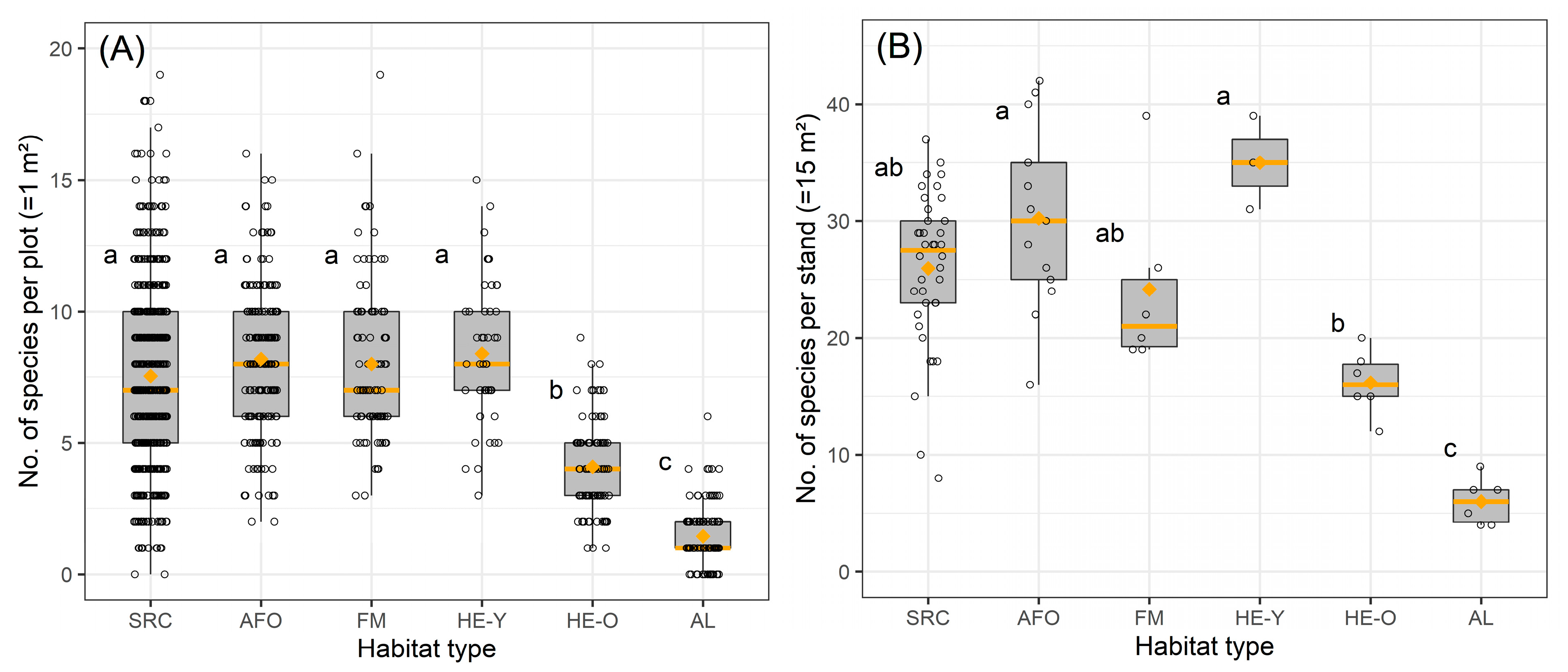
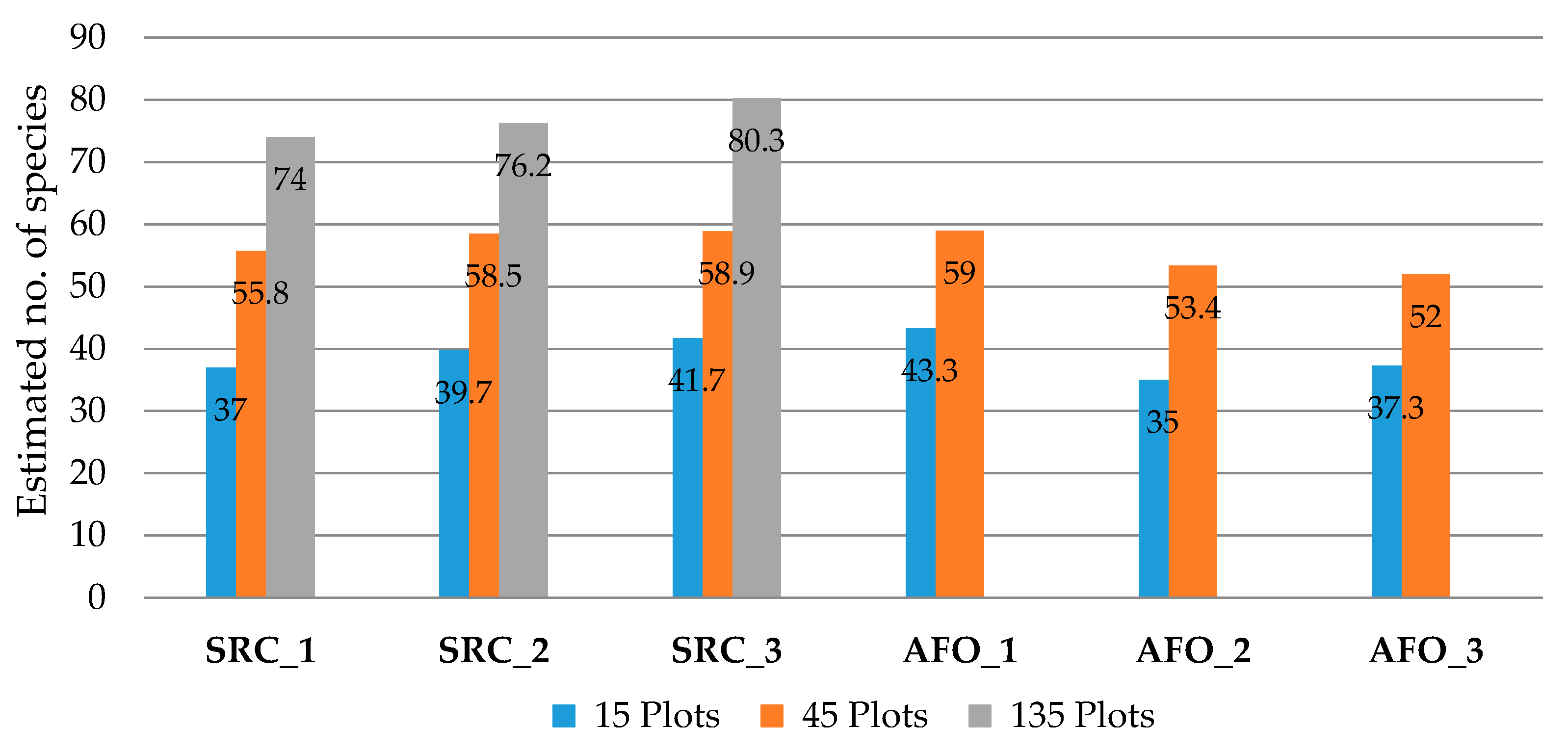
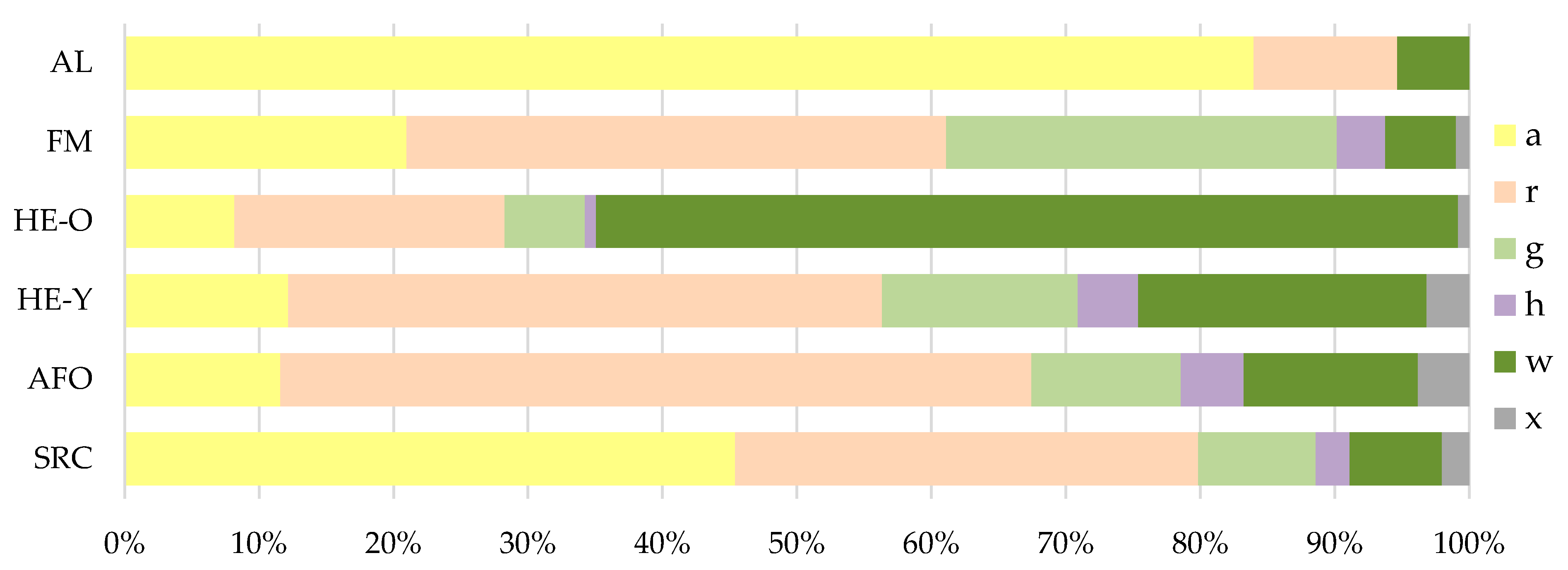
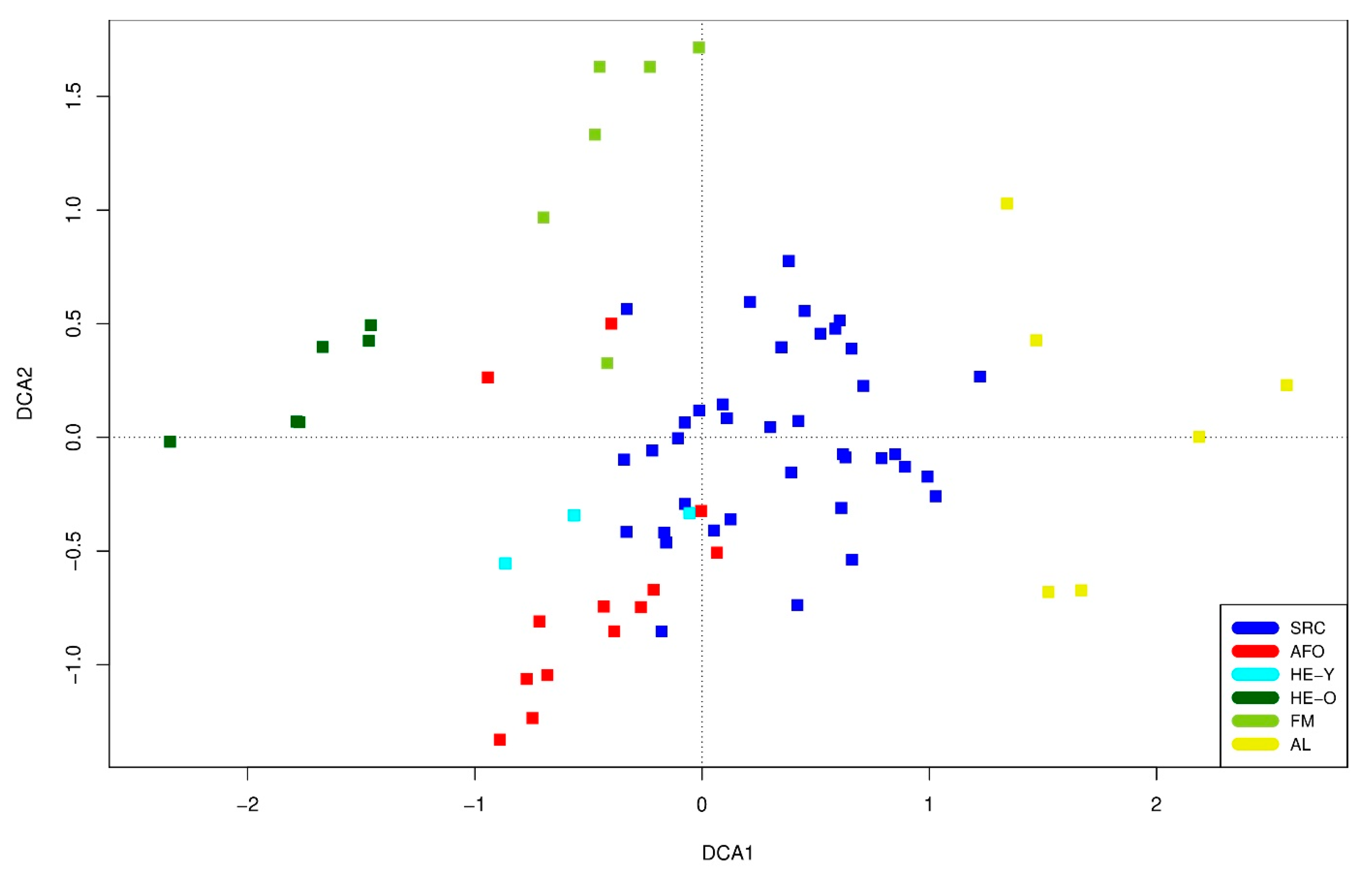
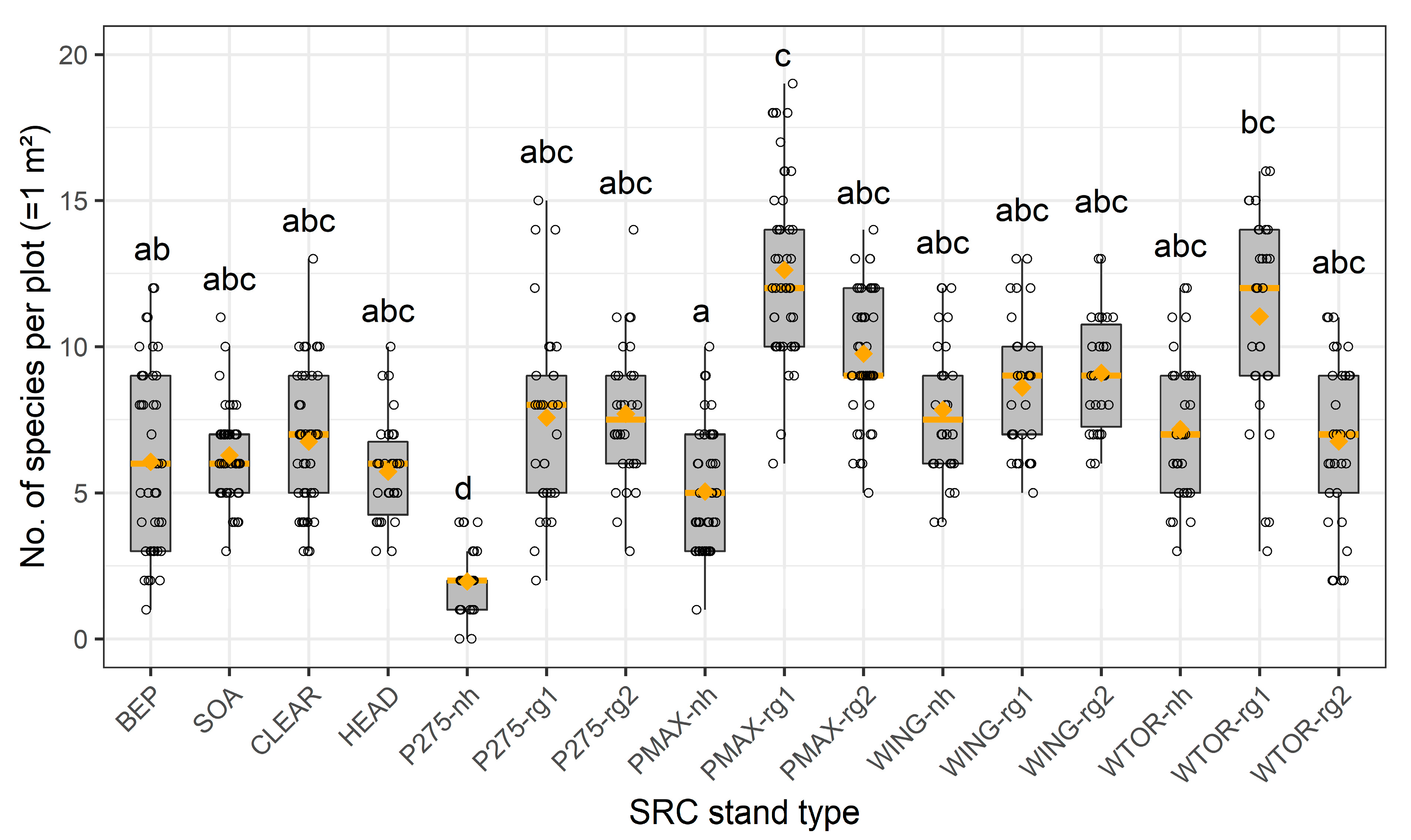
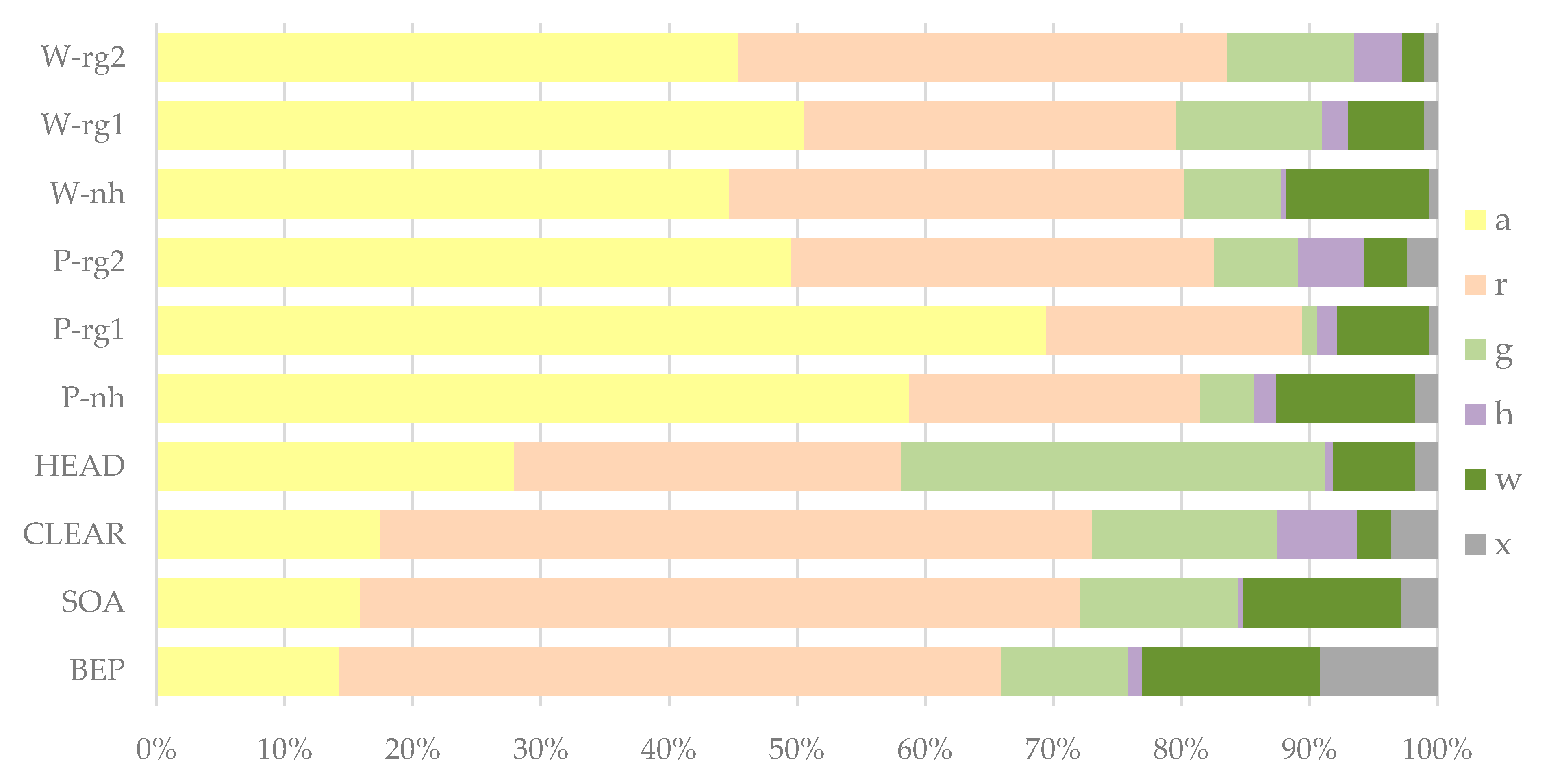
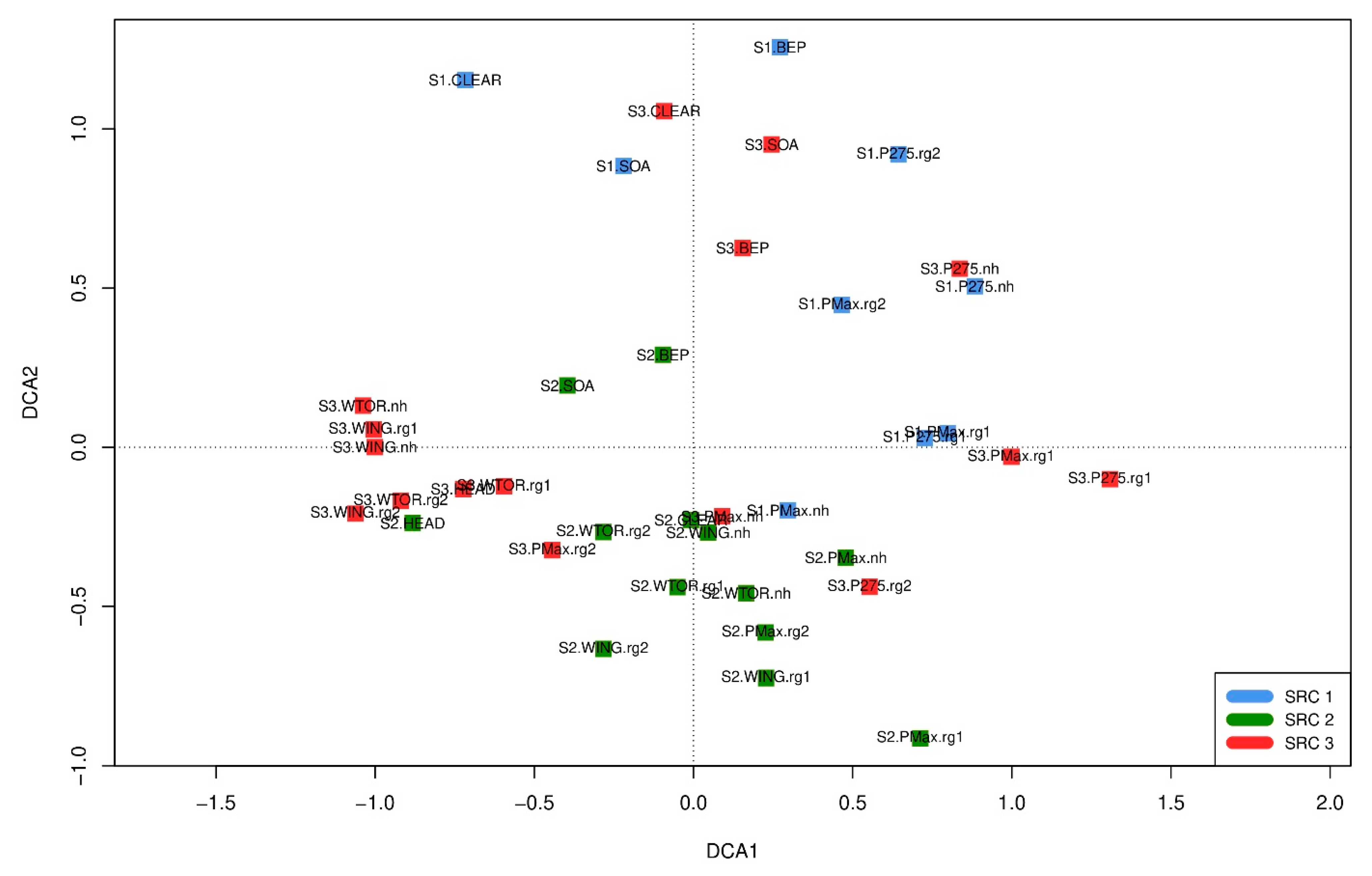
| Habitat Type | Area (ha) or Length (m) | No. of Sites (No. of Stands) | No. of Plots Per Site | No. of Plots Per Habitat Type |
|---|---|---|---|---|
| Short-rotation coppice (SRC) | 2.0–2.2 ha | 3 (38) | 135, 195, 240 | 570 |
| Afforestation (AFO) | 0.9–3.4 ha | 3 (13) | 45, 105, 45 | 195 |
| Hedge ‘young’ (HE-Y) | 180–430 m | 3 | 15 | 45 |
| Hedge ‘old’ (HE-O) | 110–230 m | 6 | 15 | 90 |
| Field margin (FM) | 70–200 m | 6 | 15 | 90 |
| Arable land (maize) (AL) | 1.6–6.0 ha | 6 | 15 | 90 |
| SRC Stand Type | Abbrev. | No. of Stands | Planting Scheme (stools/ha) | Stools/ha (Incl. Failures) | Tree Height (m) | |
|---|---|---|---|---|---|---|
| Poplar ‘Max 3’ | non-harvested | PMAX-nh | 3 | 2 × 0.5 (10,000) | 12–15 | |
| 2nd-year regrowth | PMAX-rg2 | 3 | 6000–7500 | 3–5 | ||
| 1st-year regrowth | PMAX-rg1 | 3 | <0.5 | |||
| Poplar ‘Hybride 275′ | non-harvested | P275-nh | 2 | 2 × 0.5 (10,000) | 12–15 | |
| 2nd-year regrowth | P275-rg2 | 2 | 5000–7500 | 2–3 | ||
| 1st-year regrowth | P275-rg1 | 2 | <0.5 | |||
| Willow ‘Inger‘ | non-harvested | WING-nh | 2 | 2 × 0.75 × 0.6 (12,000) | 8–10 | |
| 2nd-year regrowth | WING-rg2 | 2 | 8000–10,000 | 2–3 | ||
| 1st-year regrowth | WING-rg1 | 2 | <0.5 | |||
| Willow ‘Tordis‘ | non-harvested | WTOR-nh | 2 | 2 × 0.75 × 0.6 (12,000) | 8–10 | |
| 2nd-year regrowth | WTOR-rg2 | 2 | 8000–10,000 | 2–3 | ||
| 1st-year regrowth | WTOR-rg1 | 2 | <0.5 | |||
| Sorbus aucuparia | non-harvested | SOA | 3 | 2 × 0.5 (10,000) | 8000–9000 | 2–5 |
| Betula pendula | non-harvested | BEP | 3 | 2 × 1 (5000) | 1000–3000 | 8–12 |
| Clearings | CLEAR | 3 | – | – | – | |
| Headlands | HEAD | 2 | – | – | – | |
| SRC | AFO | FM | HE-Y | HE-O | AL | ||
|---|---|---|---|---|---|---|---|
| Total no. of species (all sites included per type) | 123 | 108 | 68 | 68 | 41 | 18 | |
| Mean no. of species 1 per site/stand (=15 m2) | overall | 25.9 ± 6.6 ab | 30.2 ± 7.9 a | 24.2 ± 7.7 ab | 35 ± 4 a | 16.2 ± 2.8 b | 6 ± 2 c |
| a | 10.7 ± 4.9 a | 5.9 ± 4.5 ab | 6.8 ± 3.4 a | 4.3 ± 4.5 ab | 1.5 ± 1.6 b | 4.2 ± 1.9 ab | |
| r | 8 ± 2.9 ab | 11.7 ± 2.1 a | 7 ± 2.5 b | 11.3 ± 1.5 ab | 3.8 ± 1.3 c | 1 ± 0 d | |
| g | 2.8 ± 1.9 a | 4.5 ± 2.5 ab | 7 ± 2.7 b | 6 ± 1 ab | 1.8 ± 0.8 a | 0 ± 0 c | |
| w | 2.8 ± 2 ab | 5 ± 1.7 ac | 1.5 ± 1.1 b | 10.7 ± 2.1 c | 8.5 ± 1.6 c | 0.8 ± 0.8 b | |
| Mean no. of species 1 per plot (=1 m2) | overall | 7.5 ± 3.5 a | 8.2 ± 2.7 a | 8 ± 3 a | 8.4 ± 2.7 a | 4.1 ± 1.7 b | 1.5 ± 1.3 c |
| a | 3.4 ± 2.8 a | 1 ± 1.3 ab | 1.7 ± 1.3 a | 1 ± 1.4 ab | 0.3 ± 0.6 b | 1.2 ± 1.3 ab | |
| r | 2.6 ± 1.6 a | 4.6 ± 1.6 a | 3.2 ± 1.1 a | 3.7 ± 1.4 a | 0.8 ± 1 b | 0.2 ± 0.4 b | |
| g | 0.7 ± 0.8 a | 0.9 ± 1.1 ab | 2.3 ± 1.5 c | 1.2 ± 1 ac | 0.2 ± 0.6 ab | 0 ± 0 b | |
| w | 0.5 ± 0.8 ab | 1.1 ± 0.9 ac | 0.4 ± 0.6 ab | 1.8 ± 1 cd | 2.6 ± 1.2 d | 0.1 ± 0.3 b | |
Publisher’s Note: MDPI stays neutral with regard to jurisdictional claims in published maps and institutional affiliations. |
© 2021 by the authors. Licensee MDPI, Basel, Switzerland. This article is an open access article distributed under the terms and conditions of the Creative Commons Attribution (CC BY) license (https://creativecommons.org/licenses/by/4.0/).
Share and Cite
Zitzmann, F.; Rode, M. Short-Rotation Coppice Managed According to Ecological Guidelines—What Are the Benefits for Phytodiversity? Forests 2021, 12, 646. https://doi.org/10.3390/f12050646
Zitzmann F, Rode M. Short-Rotation Coppice Managed According to Ecological Guidelines—What Are the Benefits for Phytodiversity? Forests. 2021; 12(5):646. https://doi.org/10.3390/f12050646
Chicago/Turabian StyleZitzmann, Felix, and Michael Rode. 2021. "Short-Rotation Coppice Managed According to Ecological Guidelines—What Are the Benefits for Phytodiversity?" Forests 12, no. 5: 646. https://doi.org/10.3390/f12050646
APA StyleZitzmann, F., & Rode, M. (2021). Short-Rotation Coppice Managed According to Ecological Guidelines—What Are the Benefits for Phytodiversity? Forests, 12(5), 646. https://doi.org/10.3390/f12050646






